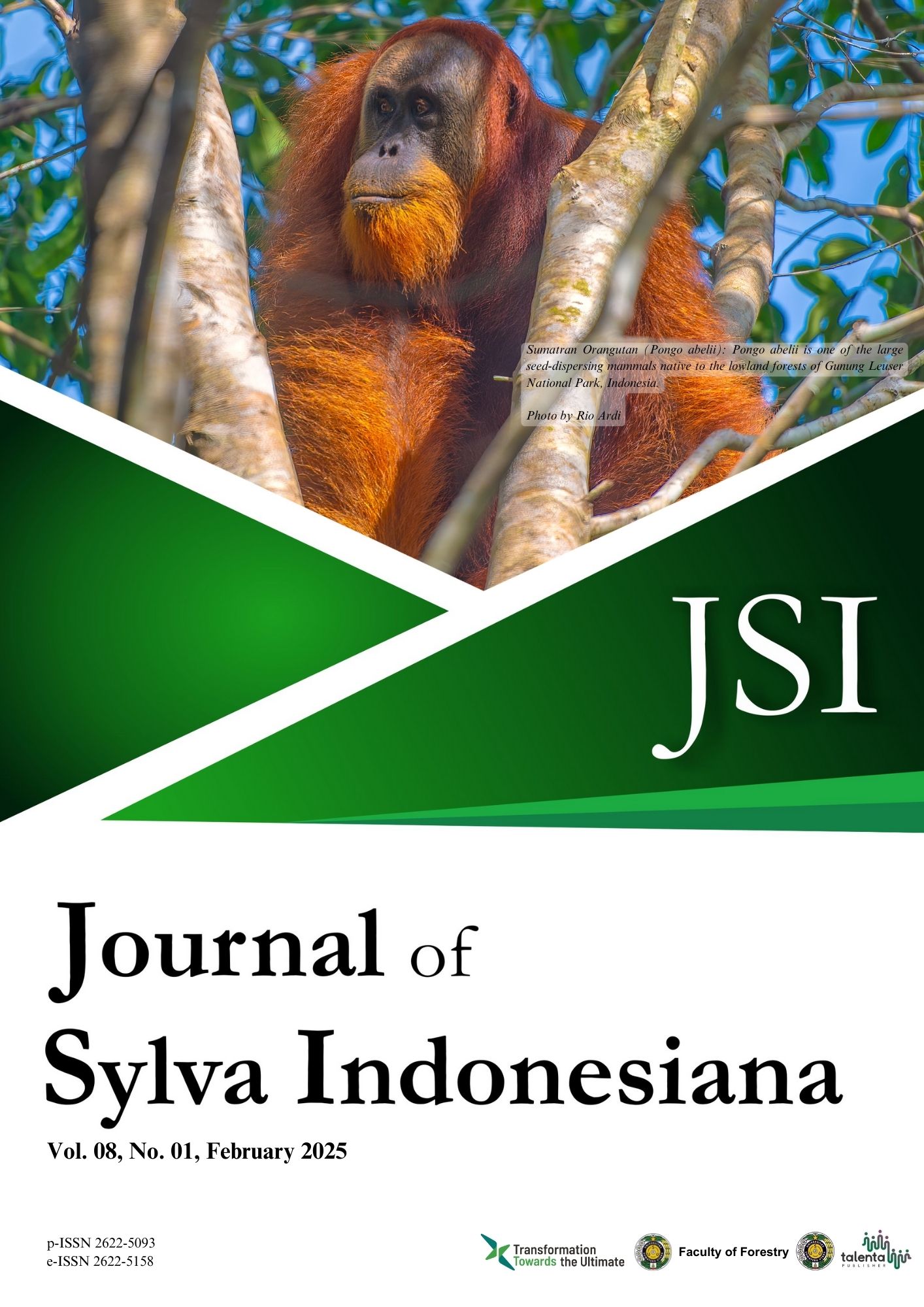Comparative Study of Physiochemical Properties and Microbial Population in Forest and Shifting Cultivation Soil in Mizoram, India
DOI:
https://doi.org/10.32734/jsi.v8i01.19339Keywords:
Forest Soil, Microbial Diversity, Shifting Cultivation, Soil Fertility, Soil PropertiesAbstract
Forest loss due to shifting cultivation (jhum) is believed to have intensified in recent years, primarily due to increasing population pressures and shorter fallow cycles. This study aims to examine the physiochemical properties and microbial population in forest soil and soil under shifting cultivation (jhum) in Mizoram, India. Soil samples were collected randomly in forest and shifting area using three depths (0 – 15 cm, 16 – 30 cm and 31 – 45 cm). Forest soil exhibited higher nitrogen (N) level, organic carbon content, moisture content and microbial diversity compared to shifting cultivation soil, which showed slightly higher phosphorus (P) level and comparable potassium (K) concentrations. Correlation revealed that forest soil had lower bulk density and higher water-holding capacity, linked to their enhanced organic matter and microbial activity. Additionally, shifting cultivation was associated with soil compaction, reduced nutrient availability and lower microbial populations, highlighting the negative impact of land-use change on soil health and ecosystem functioning. Moreover, these findings emphasize the need for sustainable land management practices to mitigate soil degradation and support soil fertility in shifting cultivation system
Downloads
References
G. Mishra, and A. Sarkar, “Studying the relationship between total organic carbon and soil carbon pools under different land management systems of Garo hills, Meghalaya,” Journal of Environmental Management, vol. 257, p. 110002, 2019. https://doi.org/10.1016/j.jenvman.2019.110002[2]
R. Saha, R. S. Chaudhary, and J. Somasundaram, “Soil Health Management under Hill Agroecosystem of North East India,” Applied and Environmental Soil Science,2012, pp. 1–9, 2012. https://doi.org/10.1155/2012/696174[3]
P. Yadav, “Slash-and-Burn Agriculture in North-East India,” Expert Opinion on Environmental Biology02, 2013. https://doi.org/10.4172/2325-9655.1000102
Journal of Sylva Indonesiana Vol.08, No.01(2025) 59-7068[4]J. Kishwan, R. Pandey, and V. K. Dadhwal, “Emission removal capability of India’s forest and tree cover,”Small-Scale Forestry, vol. 11, pp.61-72, 2012. https://doi.org/10.1007/s11842-011-9168-9[5]
M. Rawat, K. Arunachalam, A. Arunachalam, J. M. Alatalo, and R. Pandey, “Predicting litter decomposition rate for temperate forest tree species by the relative contribution of green leaf and litter traits in the Indian Himalayas region,”Ecological Indicators, vol. 119, p.106827, 2020. https://doi.org/10.1016/j.ecolind.2020.106827 [6]
M. Kumar, S. P. S. Rawat, H. Singh, N. H. Ravindranath, and N. Kalra, “Dynamic Forest vegetation models for predicting impacts of climate change on forests: An Indian perspective,”Indian Journal of Forestry,vol. 41, pp. 1–12, 2018. https://doi.org/10.54207/bsmps1000-2018-f7l9y5[7]
B. Fu, P. Xu, Y. Wang, K. Yan, and S. Chaudhary, “Assessment of the ecosystem services provided by ponds in hilly areas,”The Science of the Total Environment,vol. 642, pp. 979–987, 2018. https://doi.org/10.1016/j.scitotenv.2018.06.138[8]
A. Kumar, P. Sharma, S. Joshi, “Assessing the Impacts of Climate Change on Land Productivity in Indian Crop Agriculture: An Evidence from Panel Data Analysis,”Journal of Agricultural Science and Technology, vol.18, pp. 1–13, 2016.[9]
A. Zubedi, Z. Jianqiu, Q. A. Arain, I. Memon, S. Khan, M. S. Khan, and Y. Zhang, “Sustaining Low-Carbon Emission Development: An Energy Efficient Transportation Plan for CPEC,”Journal of Information Processing Systems,vol. 14, pp. 322–345, 2018.[10]
T. Pukkala, “Delineating forest stands from grid data,”Forest Ecosystems,vol. 7, 2020. https://doi.org/10.1186/s40663-020-00221-8[11]
U. K. Sahoo, S. L. Singh, S. S. Sahoo, L. Nundanga, L. Nuntluanga, A. S. Devi, and J. Zothansiama, “Forest Dwellers’ Perception on Climate Change and Their Adaptive Strategies to Withstand Impacts in Mizoram, North-East India,”Journal of Environmental Protection,vol. 09, pp. 1372–1392, 2018. https://doi.org/10.4236/jep.2018.913085[12]
T. Shimrah, K. S. Rao, and K. G. Saxena, “The Shifting Agricultural System (Jhum) and Strategies for Sustainable Agroecosystems in Northeast India,”Agroecology and Sustainable Food Systems,vol. 39, pp. 1154–1171, 2015. https://doi.org/10.1080/21683565.2015.1089350[13]
T. G. Vågen, M. A. A. Andrianorofanomezana, S. Andrianorofanomezana, “Deforestation and cultivation effects on characteristics of oxisols in the highlands of Madagascar,”Geodermavol. 131, pp. 190–200, 2006. https://doi.org/10.1016/j.geoderma.2005.03.026[14]
F. Khormali, and K. Nabiollahi, “Degradation of Mollisolsin Western Iran as Affected by Land Use Change,”Journal of Agricultural Science and Technologyvol. 11, pp. 363–374, 2009.[15]
P. S. Ramakrishnan, “Traditional forest knowledge and sustainable forestry: A north-east India perspective,”Forest Ecology and Managementvol. 249, pp. 91–99, 2007. https://doi.org/10.1016/j.foreco.2007.04.001[16]
J. Cherrier, S. K. Maharjan, and K. L. Maharjan, “Shifting cultivation: Misconception of the Asian governments,”Journal of International Development and Cooperation, vol. 24, no. 1-2, pp.71-82, 2018.[17]
C. Erni, “Shifting cultivation, livelihood and food security: new and old challenges for indigenous peoples in Asia,”Shifting cultivation, livelihood and food security, vol. 3, 2015.[18]
J. J. Kendawang, S. Tanaka, K. Shibata, N. Yoshida, J. Sabang, I. Ninomiya, and K. Sakurai, “Effects of Shifting Cultivation on Soil Ecosystems in Sarawak, Malaysia. III. Results of Burning Practice and Changes in Soil Organic Matter at Niah and Bakam Experimental Sites,”Soil Science & Plant Nutritionvol. 51, pp. 515–523, 2005. https://doi.org/10.1111/j.1747-0765.2005.tb00060.x[19]S. Bilen, V. Turan, Enzymatic Analyses in Soils, in: Springer Protocols Handbooks/Springer Protocols. pp. 377–385, 2022. https://doi.org/10.1007/978-1-0716-1724-3_50[20]A. J. Nath, U. K. Sahoo, K. Giri, G. W. Sileshi, and A. K. Das, Incentivizing Hill Farmers for Promoting Agroforestry as an Alternative to Shifting Cultivation in Northeast India, in: Springer eBooks. pp. 425–444, 2020. https://doi.org/10.1007/978-981-15-4136-0_14[21]S. Greipsson, and H. El-Mayas, “Large-scale reclamation of barren lands in Iceland by aerial seeding,”Land Degradation and Developmentvol. 10, no. 3, pp. 185–193, 1999. https://doi.org/10.1002/(sici)1099-145x(199905/06)10:3[22]R. W. Chia, D. G. Kim, and F. Yimer, “Can afforestation with Cupressus lusitanica restore soil C and N stocks depleted by crop cultivation to levels observed under native systems?,”Agriculture, ecosystems & environment, vol. 242, pp.67-75, 2017. https://doi.org/10.1016/j.agee.2017.03.023
Downloads
Published
How to Cite
Issue
Section
License

This work is licensed under a Creative Commons Attribution-ShareAlike 4.0 International License.



















